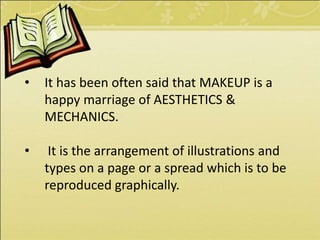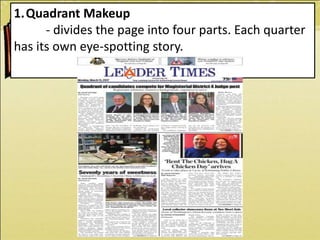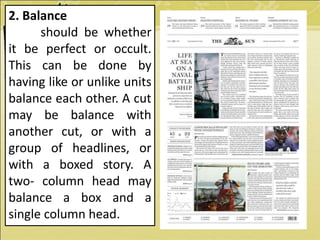Layout and Makeup
- 1. LAYOUT/MAKEUP By: Pingoy, Maria Lucia Pacala, Cresilda Pacamara, Ruby
- 4. • It has been often said that MAKEUP is a happy marriage of AESTHETICS & MECHANICS. • It is the arrangement of illustrations and types on a page or a spread which is to be reproduced graphically.
- 5. A newspaper should be carefully and properly laid out: 1. To give prominence to the news in proportion to is importance. 2. To make the different contents easy to find and to read. 3. To give the pages an attractive appearance. 4. To give the paper a personality of its own.
- 6. An effective makeup may be planned using two procedures: 1. Page makeup is a matter of personal taste. There are no absolute criteria for laying out the page or pages of a newspaper or a magazine; therefore, the layout artist may experiment freely on page makeup until he gets the pattern that is acceptable to him.
- 7. 2. There are many forms of front page makeup, it’s good to know them, but this does not mean that the staff can’t devise its own.
- 8. Types of Front Page Makeup By Way of Headline and Text Arrangement
- 9. 1. Perfect Balance Makeup (Balance or Symmetrical Makeup) - A large headline placed, for example in the right-hand column front page, is balanced with a corresponding large one in the first and second column. -Other headlines are similarly arranged. A one- column cut at the top of the column four .
- 10. This kind of makeup gives a static, monotonous appearance to the paper . It should not be made from issue to issue although The New York Times is noted for this.
- 11. 2. Brace or Focus Makeup - Headlines are diagonally arranged from the upper left to the lower right hand corner or vice- versa just like a brace supporting a house. - balance is obtained by various devices such as two column heads, boxes, and cuts which are used to offset the weight concentrated in the upper right or upper left hand corner .
- 12. This kind of makeup is desirable to use when one story is more important than any other because the reader’s attention is directed to the upper right-hand corner or occasionally to the upper left.
- 13. 3. Broken Column Makeup - the page is broken into several units to give space to many stories. -symmetry is obtained be carefully arranging the contents so as not to cancel each other by their nearness. Large heads and cuts are placed where they give the page a pleasing pattern.
- 14. This kind of makeup is developed primarily to be able to print as many short news stories on Page 1 as possible.
- 15. 4. Occult Makeup - type groups are arranged at varying distances from the center like two boys on a see-saw. -it is sometimes called occult or hidden balance because the type group with its headline may be balanced with a picture, an illustration or a bow instead of another type group.
- 16. No attempt is made to achieve perfect balance. This is one of the most popular kinds of front page makeup since it permits great variety fro, issue to issue.
- 17. 5. Streamline Makeup - the format is similar to that of the contrast and balance makeup. However the nameplate is , usually floated, headlines are flushed up in cap and lower- case (clc) type, and large body types are often used. -instead of boxing stories in full, three quarter boxes are restored to.
- 18. Often, bullets, asterisks, or Jim dashes are employed to introduce lead stories. This kind of makeup is more commonly used by high school papers than by the national dailies.
- 19. 6. Circus Makeup - it is broken-column carried to the extreme. The page is broken up with no attempt at regularity symmetry or order , , . -Many headlines of all size; boxes and cuts are scattered all over the page, each clamoring for attention, and screaming as barkers carnival circus do. There is no focus of interest.
- 20. This kind of makeup is not desirable for high school papers. The Peoples Journal, a metropolitan daily has , adopted this kind of makeup.
- 21. Makeup By Way of Text and Photo Combination
- 22. 1. The X Format
- 23. 2. The Curve Format
- 24. 3. The L format
- 25. 4. The J Format
- 26. 5. The Umbrella Format
- 27. The work of putting out an attractive newspaper is jointly the efforts of the editors and his staff around him. • The staff is composed of what we call in newspaper parlance as deskmen. - they are the makeup men and layout men. - they decide on the general appearance of the newspaper.
- 28. • Dummy sheet - a piece of paper which has measurement in length and in depth and will determine more or less the pages. the main consideration in preparing the page is that it should be as attractive as possible.
- 30. 1.Quadrant Makeup - divides the page into four parts. Each quarter has its own eye-spotting story.
- 31. 2. Horizontal Makeup - the appearance of the page is horizontal rectangles. The effect on the eyes is made by using multi-column heads; the eyesight travels horizontally.
- 32. 3. Circus Makeup - which is really like a circus. All harmony is thrown to the winds. No symmetry, and there are sensational pictures or boxed human interest stories.
- 33. 4. Brace Makeup - the brace is characterized by angular shelf-like arrangement of content. The deskman usually projects the effect by making a four-column head, that is what you call a red-out or a drop- head of, two columns or three-columns.
- 34. Make up of Inside Pages
- 35. 1. For News Pages Inside news pages should be laid as facing page units rather than as single pages. The principles of contrast and balance used for front page makeup should also be applied in planning the makeup of facing pages.
- 37. 2. For Editorial Pages These pages should have a distinctive, dignified, and formal appearance. The masthead or editorial box which should be relatively small, may be anchored in any corner as done in streamlined newspapers. Traditionally the editorials appear in , the first two columns. They are of larger types. Heads or titles of editorials, just like the headline of news stories should be of the masculine appearance, not the italic or the script type.
- 39. 3. For Feature and Literary Pages These pages must have a literary and feminine appearance. The columns are often wider Roman and italics types are used for text.
- 40. 4. For Sports Page These pages have a bolder but more lively appearances than other pages. Their makeup should suggest their content, action, speed, and color. Large bold heads, even streamers are used.
- 41. Principles to Follow to Achieve Effective Makeup
- 42. 1. Unity the content of every page and of every double page spread should blend into a harmonious unit. No one part of the page should overshadow another. The headlines should complement each other and the picture should not distract the eyes too much.
- 43. 2. Balance should be whether it be perfect or occult. This can be done by having like or unlike units balance each other. A cut may be balance with another cut, or with a group of headlines, or with a boxed story. A two- column head may balance a box and a single column head.
- 44. 3. Emphasis in order to achieve emphasis, news should be displayed according to importance. The news value of every story must be determined as to what page it should find print, its position on the page, and the style and size of its headline. News stories should be graded according to value or importance to the public and should be given the corresponding size and style of headline they deserve.
- 46. 4. Movement there is no movement in perfect balance. With occult balance, the eye is directed from one part of the page to another—from the most important to the least important.
- 47. 5. Proportion the picture must sized properly to keep up with other shapes on the page, Square cuts are undesirable. The length of the stories should be considered. A long story may ruin the proportion of the page.
- 48. 6. Contrast Each story and cut should have an individuality of its own. This can be achieved if units blends together as one. Every head and cut on a page should contrast with ad joining materials. Contrasting adjacent headlines will help emphasize between heads are sometimes good makeup devices.
- 50. Do’s & Don’ts in Page Makeup
- 51. 1. Avoid tombstoning - placing two or more headlines on approximately the same level in adjacent columns especially if they are of the same point and types.
- 52. 2. Avoid separating related stories and pictures. If possible, avoid jumpheads.
- 53. 3. Avoid using a banner headline unless the story deserves it. Screaming headlines should not also be used. A screaming headline is one that is too big for a short or unimportant story.
- 54. 4. Don’t make the page top heavy, making the top half of the page heavy with cuts and big headlines.
- 55. 5. Avoid many headlines of the same size on a page.
- 56. 6. Avoid placing small heads on rather long stories.
- 57. 7. The average number of stories on page 1 of a tabloid is from seven to nine stories.
Editor's Notes
- #22: Last meeting one of my groupmate already started to report about layout or makeup, its definition and the types of front page make up. This morning I am going to report about make up by way of text and photo combination… There are 5 different types of format in make up by way of text and photo combination namely the x format, curve format, the l format, the j format and the umbrella format.
- #23: It is very understandable, it forms like a letter x…. This part here is for the pictures and this part here is intended for the text.
- #24: It forms like a curve….. This are the pictures and for the text.
- #25: The l format forms like a letter l…. so this is an ex, of l format..
- #26: Then the j format… forms like a letter j… the sample picture is an inverted letter j.
- #27: The last one is the umbrella format which are pictures are scattered from left to right on the upper part of the paper and another one picture on the lower part.
- #29: layout of a newspaper page, showing the placement of stories, headlines, pictures and advertisements. This dummy sheet will determine if how many pages will be used. ……. Why is it that in preparing the page it should be as attractive as possible? ….. So that it could easily catch the attention of the readers.
- #30: Some of the layout that stated here was already discussed by the first reporter…. So recap nlang.
- #31: For example in PDI and the philippine star news paper. There were 4 pictures and each of these has its own eye=spotting story… these is what we call the quadrant make up.
- #32: Take a look at the picture…. The appearance is horizontal rectangles that’s why eyesight travels horizontally.
- #33: Many headlines of all size; boxes and cuts are scattered all over the page, each clamoring for attention, and screaming as barkers carnival circus do.
- #34: makeup is desirable to use when one story is more important than any other because the reader’s attention is directed to the upper right-hand corner or occasionally to the upper left.
- #35: While it is true that the front page of the news paper is a show window, attractive makeup should not be confined to this page alone. The inside and back pages should be given the same tender care, treatment and attention by the layout artist.
- #36: It means that, what is the appearance in the front page, must also be considered in planning the makeup of facing pages. It still should have balance and contrast.
- #38: So, when we say distinctive, it is unique and dignified, it is serious or somewhat formal. So, this pages should have a unique and formal look to the readers. It should not be the Italic or the script type.
- #40: So, Feature and Literary Pages must have a feminine appearance, it should form with creativity so that it can catch the attention of the readers.
- #42: So we, as a journalist we should follow principles in achieving effective makeup.
- #43: All pages that included in the news paper should equally important. So in making news papers, we should know how to balance. The pictures, headlines and box stories.
- #45: So, we as a journalist or news writers. We should only include important news. We should determined the position, style and size of its headline.
- #49: Contrast from the word itself. To be different. Adjacent- close or near.
- #52: Tombstoning in page layout, putting articles side by side so that the headlines are adjacent. The phenomenon is also referred to as bumping heads. Adjacent can refer to two things that touch each other or have the same wall or border.

























































